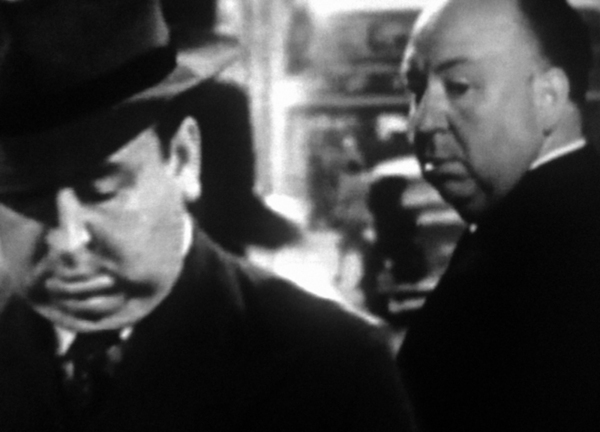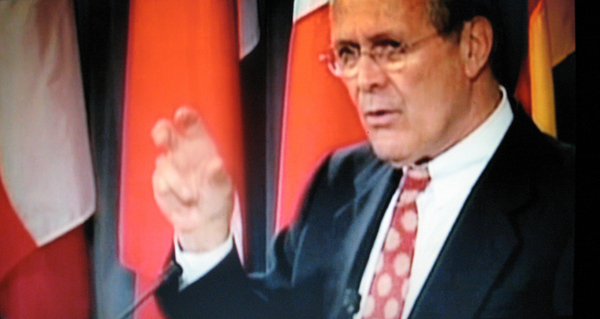This is an archive of the ArtCat Zine, 2007-2009. Please visit our new project, IDIOM.
Johan Grimonprez at Sean Kelly
Double Take
Johan Grimonprez
Sean Kelly - 528 W. 29th St, New York NY
7 March - 21 March 2009
Folgers coffee has never been so apt a metaphor. Johan Grimonprez's new film Double Take, on view this month at Sean Kelly Gallery in Chelsea, is punctuated by several decades' worth of advertisements for it, and for good reason: it's the archetypal “double.” The doting wife, always unable to satisfy her husband's quasi-erotic demands for good brewed coffee, replaces it with instant. The husband can't tell the difference — but the audience is left with an uncanny sense of foreboding, as if its own coffee cups were in imminent danger of being surreptitiously substituted for something else. This vague anxiety is the foremost feeling evoked, and cultivated, by Grimonprez's film.
Double Take is a long and tightly-controlled examination of the double on a variety of levels, yet it remains admirably disciplined in its selection of motifs. The topic, after all, is so extensive and so firmly-rooted in Western culture — another artist would have felt obliged to reference Cervantes or Joseph Conrad — that a treatment trying for breadth would inevitably have become a catalogue.
Here, there are only a few primary strands to untangle. The spine of the story is provided by a Borges essay, reworked into a preternaturally plausible account of Alfred Hitchcock meeting his double. Hitchcock's doubles in fact populate the whole film, along with Hitchcock's own on-screen and off-screen personae. The difference between the two becomes less clear and less relevant as the narrative proceeds; by the end, we are left with barely anything more than the stylized, trademark silhouette, filled out by an ever-shifting array of characters. The original Hitchcock, it seems, cannot help becoming his own murder victim — for, the film insists, if you meet your double, you must kill him.
By itself this storyline would be not only impressive but faithful to both of its illustrious antecedents. Yet, for Grimonprez, Hitchcock's beloved theme of threatened domesticity is inseparable from its mass-cultural Cold War context. He introduces the film's second focus — the struggle between the United States and the Soviet Union as a pair of doubles bent on killing each other — not with the more familiar Berlin Airlift or the end of World War II, but with the 1959 “Kitchen Debate” between Nixon and Khrushchev. This encounter was supposed to have been about the two superpowers' competing approaches to the standard of living, but as it is rendered in Double Take, it is about one thing: television.
Hitchcock's oft-cited aphorism — “Television brought murder into the American home, where it has always belonged” — thus acquires a deeper meaning. Television, cinema's double, did not simply titillate the home viewer with staged murders and advertisements: it brought him face-to-face with his double, the Evil Empire on the other side of the Atlantic. The mounting feeling of urgency brought on by Sputnik or the latest nuclear menace was inevitably mediated through the television screen, a machine that shaped politics as much as it was shaped by it. And behind those images of Soviet cosmonaut dogs and missile tests, the screen disclosed threatening doubles more primal still, partaking more of Hitchcock's birds than of Marx and Lenin.
Double Take is at its most disappointing when it abandons this train of thought. A somewhat hackneyed critique of consumerism dogs his analysis of television; while a retread of Cold War history plods along predictably before finally collapsing into an attack on those well-worn hobbyhorses, Reagan and Rumsfeld.
This didacticism frustrates precisely because it does so little justice to the conceptual depths of Grimonprez's own project. After all, one of the double's most haunting traits is that it leaves us uncertain about whether it really is a double, or merely some kind of trick — something Double Take's Hitchcock tries desperately to figure out. So when Soviet Russia manifests itself so forcefully through the television screen, we have an opportunity to confront and challenge received notions of who America's double really is. Is the struggle really between two countries elevated to the level of abstract principles? Or might the televised opponent be something different — a hazy and slippery projection of the nation's anxieties and fears, linked metaphorically and quite inadequately to a concrete geopolitical fact? For Grimonprez, unfortunately, the answer seems all too certain.
ZINE
HOME
TIPS / COMMENTS
CATEGORIES
CONTRIBUTORS
- Greg Afinogenov
- B. Blagojevic
- Adda Birnir
- Susannah Edelbaum
- Julie Fishkin
- Paddy Johnson
- Jessica Loudis
- Christopher Reiger
- Andrew Robinson
- Peter J. Russo
- Blythe Sheldon
- S.C.Squibb
- Hrag Vartanian


